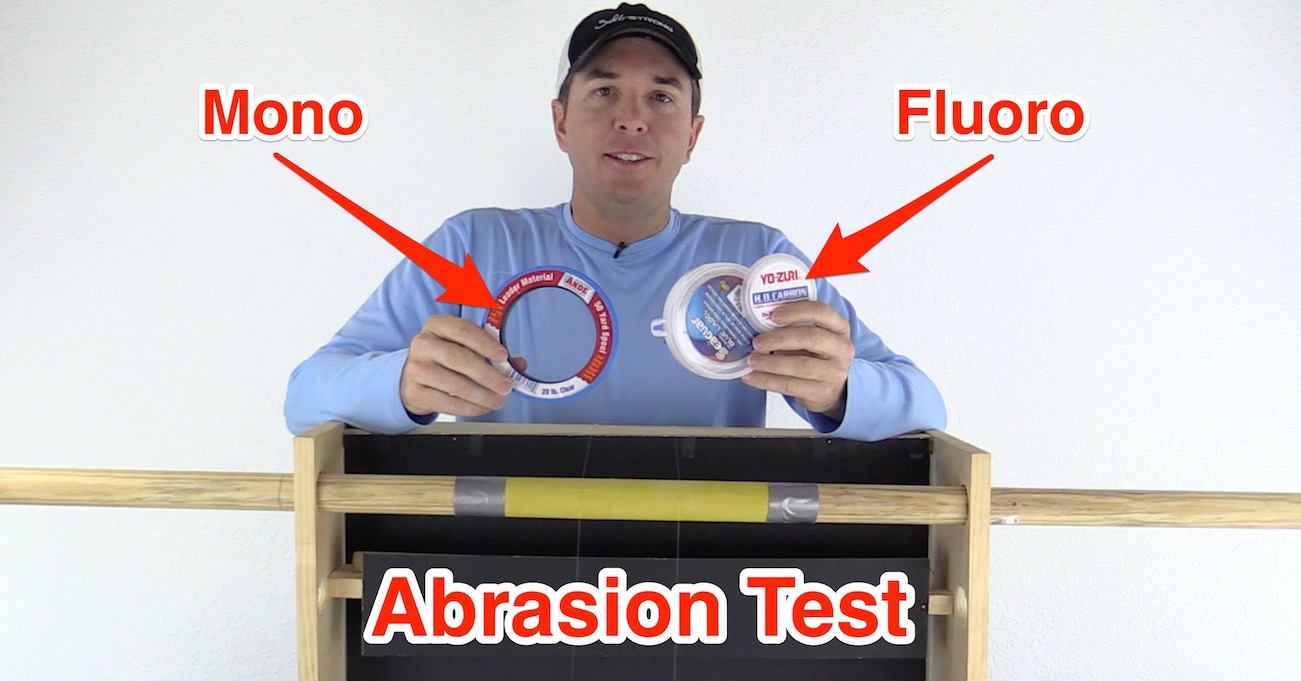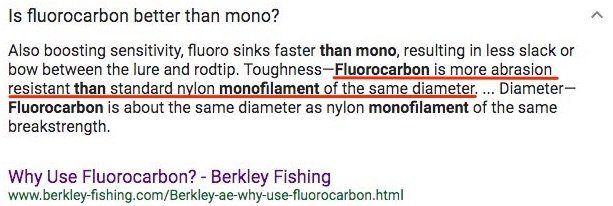Is Fluorocarbon Leader More Abrasion Resistant Than Traditional Mono Leader?
- By: Luke Simonds
- on

It’s line testing time again!
And just wait until you see the video below with the somewhat shocking results…
This latest test is directed at the commonly held belief that fluorocarbon leader is more resistant to abrasion than monofilament.
Based on feedback from the Salt Strong community, I tested the difference in abrasion between fluoro and mono for the following two scenarios:
- They both have the same rated strength (20 lbs)
- They both have the same diameter (20 lb mono vs. 25 lb fluoro)
And so far, this test has been the most shocking of all because my prior belief was completely thrown in the gutter.
Here’s the backstory:
Over the past couple of months, I started a quest to determine what the best line is in terms of its true value.
The overall goal of these experiments is to better understand the facts vs. the marketing-induced hype.
So far, some of the results have been very surprising because they completely uncovered some HUGE myths about our beloved fishing line.
And for me, this latest test is at the top of the list.
Line Testing Summary
After publishing several line analysis experiments using the testing platform shown below, the most common suggestion was to perform some tests on fluorocarbon line against traditional monofilament line.

So I began doing some research to see what the hype between the two lines seemed to be so that I could determine what tests to start out with.
So I’ll walk you through the thought entire process from test creation to final conclusion in this article.
But first, let’s quickly talk about a much-needed clarification:
What’s The Difference Between Fluorocarbon and Monofilament Fishing Line

This is a very common question that we receive, and the quick answer is that they both are monofilament lines.
Fluorocarbon line is just a subset of monofilament that is becoming more and more popular as of late.
It’s becoming so popular, that most people think of it as its own class of line… so I’ll frame this post as if they are two classes since they are most commonly thought of that way in terms of expected performance in addition to their perceived value and sticker price.
In general, fluorocarbon is favored by many anglers because it is commonly known to be superior to traditional monofilament line for the following core reasons:
- Less visible in the water – This claim is made mostly due to the density of fluorocarbon being closer to that of water which makes for less refraction of light. Fluoro typically has a thinner diameter relative to its strength, so that feeds into this core benefit as well.
- More resistant to abrasion – This claim seems to be made across the board, and I can only assume it’s due to simply equating that increased density means increased abrasion resistance [this is the factor that I examined in this test]
- Better performance characteristics – There seem to be a lot of hype around fluoro being better due to it having less stretch, a faster sinking rate, and a variety of other things that we’ll cover in a different post.
For now, let’s just focus on the abrasion characteristic because that’s what this latest experiment is all about.
Online Research Results On Fluoro vs. Mono Abrasion
Here are some snapshots of the information I found when performing some research online courtesy from our dear friends at Google.
The online reports seem to be overwhelmingly favorable to fluorocarbon when it comes to abrasion relative to monofilament line.
Here’s an example from a detailed post about fluorocarbon vs. mono line where it clearly shows that fluorocarbon is the superior choice due to its density/hardness:

And here’s another top-rated result from the research where it states that fluorocarbon is more abrasion resistant than mono when their diameters are equal to one another… not quite as lofty a claim as before, but still very confidently showing fluoro as the superior line.

I went through a good amount of articles, but never once did I see a test done on this important aspect of a leader line, so that’s when I just knew that I had to try it out even though the answer seemed so obvious…
So with that said, let’s dive into this latest experiment:
Is Fluorocarbon Leader Really More Abrasion Resistant Than Mono?
The test is shown in detail in the video below.
As you’ll see, I performed two tests isolating the following characteristics for the two tests:
- Rated Strength (2o lb leader lines used in this test)
- Line Diameter (resulted in a 20 lb mono going against a 25 lb fluorocarbon line)
Click the video below to see what happened:
Conclusion
After being blown away by the fact that the traditional monofilament line beating two different brands of fluorocarbon that was supposed to be stronger, I did some more research to see if I missed something.
One thing I found in this research was that monofilament can lose some of its strength after being submerged in water for an extended period of time.
So I soaked mono in water for over 15 minutes before testing it again against the same two fluorocarbon lines, and it still won by roughly the same margin.
Of course, this single test with just a few lines can’t prove once and for all if monofilament is or is not more abrasion resistant than fluorocarbon because I’m sure the results vary depending on the lines used…
But in my opinion, this experiment at least squashes the theory that fluorocarbon line are all stronger than monofilament lines.
There will be a lot more testing, so please let me know if you have any suggestions for improving the future experiments.
And let me know what lines you’d like me to try out as well.
Fish On!
P.S. – Please be sure to share this post with any of your friends who use fluorocarbon leaders so that they know their trusted leaders may not be as strong as they thought… this test sure made me reconsider the leaders that I use.
Related Posts:
- Is Fluorocarbon Leader Stronger Than Fluorocarbon Main Line? Find Out Here
- Knot Strength Experiment: Blue Label vs Red Label Seaguar Leader Line
See More Fishing Line Tests/Reviews
Related categories:
STOP WASTING TIME ON THE WATER!
Do what the “SMART ANGLERS” are doing and join the Insider Club.
Here’s what you’ll receive today when you join:
- Weekly fishing reports and TRENDS revealing exactly where you should fish every trip
- Weekly “spot dissection” videos that walk you through all the best spots in your area
- Exclusive fishing tips from the PROS you can’t find anywhere else
- Everything you need to start catching fish more consistently (regardless if you fish out of a boat, kayak, or land).









Interesting! But I switched to fluorocarbon because of the alleged invisibility factor. Now I wonder if that is true?
Very interesting. I fly fish for baby tarpon and I recently switched my leader material from straight mono to fluro. I have not noticed any difference after the switch and I was always curious. Just curious how the mason mono would measure in your test. The mason has been advertised for years as a “hard” abrasion resistant mono. Thanks for the study!
It’s always been said fishing tackle is to catch fisherman not fish, there is more of your proof.
Wow that was very eye-opening. I would’ve bet that fluorocarbon is the best. I’m looking forward to further testing Ie strength, stretch and line clarity in water.
I always wondered about this. Good to know this part of it. A visibility test would be great to see
Thank you for your time and investigation on these test. I have made some tests of my own and found out that mono is stronger than floral carbon. Looking forward to your Visibility test.
I had been used to using mono for fishing and leader lines… Decided to toss my hat in the flourocarbon group for a minute… This just sent me back over to mono
Agreed with Andrew’s question!!!
I’ve been using regular flouro line for years instead of flouro leader ( freshwater trout…you know: rainbows, browns, brookies) because it’s ridiculously cheaper and it just doesn’t make sense that leader material is really THAT much different ( if AT ALL).
Thanks so much for doing REAL WORLD tests!
You guys are awesome!
If I lived closer to good S.W. I’d definitely join. ( I’m 3.5 hours from VA beach and on vacation fish Ft Fisher N.C. but that’s like 1 week a year)…
So for now, I just watch your YouTube videos and wish I was closer
Thanks for making time to post the nice comment Brian!
It would be interesting to see the difference running it across the sand paper longitudinally versus laterally (as if being dragged across a dock piling).